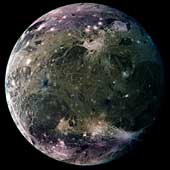|
COMETS EARTH JUPITER KUIPER BELT MARS MERCURY METEORITES NEPTUNE OORT CLOUD PLUTO SATURN SOLAR SYSTEM SPACE SUN URANUS VENUS ORDER PRINTS
PHOTO CATEGORIES SCIENCEVIEWS AMERICAN INDIAN AMPHIBIANS BIRDS BUGS FINE ART FOSSILS THE ISLANDS HISTORICAL PHOTOS MAMMALS OTHER PARKS PLANTS RELIGIOUS REPTILES SCIENCEVIEWS PRINTS
|
Related Document
Download Options
In this global view of Ganymede's trailing side, the colors are enhanced to emphasize color differences. The enhancement reveals frosty polar caps in addition to the two predominant terrains on Ganymede, bright, grooved terrain and older, dark furrowed areas. Many craters with diameters up to several dozen kilometers are visible. The violet hues at the poles may be the result of small particles of frost which would scatter more light at shorter wavelengths (the violet end of the spectrum). Ganymede's magnetic field, which was detected by the magnetometer on NASA's Galileo spacecraft in 1996, may be partly responsible for the appearance of the polar terrain. Compared to Earth's polar caps, Ganymede's polar terrain is relatively vast. The frost on Ganymede reaches latitudes as low as 40 degrees on average and 25 degrees at some locations. For comparison with Earth, Miami, Florida lies at 26 degrees north latitude, and Berlin, Germany is located at 52 degrees north. North is to the top of the picture. The composite, which combines images taken with green, violet, and 1 micrometer filters, is centered at 306 degrees west longitude. The resolution is 9 kilometers (6 miles) per picture element. The images were taken on 29 March 1998 at a range of 918000 kilometers (570,000 miles) by the Solid State Imaging (SSI) system on NASA's Galileo spacecraft. |
